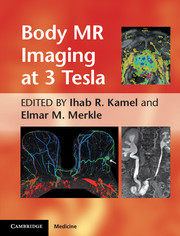Book contents
- Frontmatter
- Contents
- Contributors
- Foreword
- Preface
- Chapter 1 Body MR imaging at 3T: basic considerations about artifacts and safety
- Chapter 2 Novel acquisition techniques that are facilitated by 3T
- Chapter 3 Breast MR imaging
- Chapter 4 Cardiac MR imaging
- Chapter 5 Abdominal and pelvic MR angiography
- Chapter 6 Liver MR imaging at 3T: challenges and opportunities
- Chapter 7 MR imaging of the pancreas
- Chapter 8 MR imaging of the adrenal glands
- Chapter 9 Magnetic resonance cholangiopancreatography
- Chapter 10 MR imaging of small and large bowel
- Chapter 11 MR imaging of the rectum, 3T vs. 1.5T
- Chapter 12 Imaging of the kidneys and MR urography at 3T
- Chapter 13 MR imaging and MR-guided biopsy of the prostate at 3T
- Chapter 14 Female pelvic imaging at 3T
- Index
- Plate section
- References
Chapter 12 - Imaging of the kidneys and MR urography at 3T
Published online by Cambridge University Press: 05 August 2011
- Frontmatter
- Contents
- Contributors
- Foreword
- Preface
- Chapter 1 Body MR imaging at 3T: basic considerations about artifacts and safety
- Chapter 2 Novel acquisition techniques that are facilitated by 3T
- Chapter 3 Breast MR imaging
- Chapter 4 Cardiac MR imaging
- Chapter 5 Abdominal and pelvic MR angiography
- Chapter 6 Liver MR imaging at 3T: challenges and opportunities
- Chapter 7 MR imaging of the pancreas
- Chapter 8 MR imaging of the adrenal glands
- Chapter 9 Magnetic resonance cholangiopancreatography
- Chapter 10 MR imaging of small and large bowel
- Chapter 11 MR imaging of the rectum, 3T vs. 1.5T
- Chapter 12 Imaging of the kidneys and MR urography at 3T
- Chapter 13 MR imaging and MR-guided biopsy of the prostate at 3T
- Chapter 14 Female pelvic imaging at 3T
- Index
- Plate section
- References
Summary
Introduction
The use of MR imaging for assessment of the urinary tract is not a new concept. However, MR imaging of the kidneys, ureters, and bladder remains a seldom performed technique at many medical centers, in part due to the dominant role computed tomography (CT) has played for the evaluation of urinary tract neoplasms and stone disease. Growing interest in medical radiation dose reduction coupled with advances in MR imaging technology has stimulated interest in renal MR imaging and MR urography. While contrast resolution has been a major advantage of MR imaging over other imaging modalities for many body applications, the limited temporal and spatial resolution of MR imaging, in addition to its relative insensitivity for detecting calcifications, have impeded the widespread adoption of MR imaging for urinary tract imaging.
- Type
- Chapter
- Information
- Body MR Imaging at 3 Tesla , pp. 164 - 177Publisher: Cambridge University PressPrint publication year: 2011
References
- 1
- Cited by



